| |
|
 |
| |
|
a n d o t h e r D r i v e w a y
D i n o s a u r s |
|
|
|
|
Family Wagons | Chevrolets | Oldsmobiles | Pontiacs |
|
|
|
by Stacy Scharch |
|
|
|
Cars that sat in our driveway and our neighbors'
long ago. These relics wandered the
suburbs, creeping up and
down streets with families inside. Rare and
collectable to some, the station wagon was the SUV
of the '60s and '70s. They didn't tower above,
like today's minivans. You could actually see
around them on the highway,
when everyone rode at the same height. |
|
|
|
|
|
|
|
| |
|
|
|
1954 Chevrolet
Bel Air Townsman
4 Door, 8 passenger Station Wagon
Color: Horizon Blue
Nickname: "Bitty Blue Bus"
|
MSRP: |
$2,090.00 |
|
Model no.: |
2419 |
|
Produced: |
8,156 units |
|
Engine type: |
I-6 OHV |
|
Displacement: |
235.5 cu. in. |
|
Horsepower: |
125 hp @ 4000 rpm |
|
Torque: |
200 lb.ft. @ 2000 rpm |
|
Compression ratio: |
7.5 : 1 |
|
Carburetor: |
1-bbl Rochester |
|
Transmission: |
2-speed Powerglide |
|
Shipping weight: |
3,540 lbs |
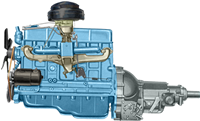
"Blue-Flame 125" six-cylinder with
Powerglide
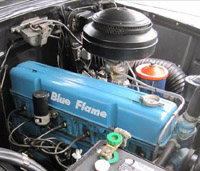
Oil bath air cleaner
|
|
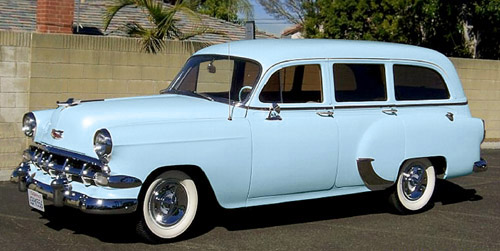
Very few wagons were produced in '54.
Our cousin's had one in Horizon Blue. It had a forward facing
third seat, and was nicknamed the "Bitty Blue
Bus". |
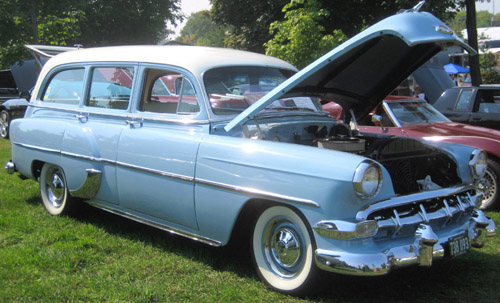
|
|
|
|
|
|
 In 1954, Chevrolet's biggest engine
for passenger cars was the Blue-Flame 125, an inline 6-cylinder.
It was 10
hp more than the Blue-Flame 115 base engine, because of
a new "High-Lift" cam. The 125 was only
available with Powerglide models, which was a 2-speed automatic
transmission. All GM divisions offered V8 engines for
their 1954 models, except
Chevrolet until 1955. In 1954, Chevrolet's biggest engine
for passenger cars was the Blue-Flame 125, an inline 6-cylinder.
It was 10
hp more than the Blue-Flame 115 base engine, because of
a new "High-Lift" cam. The 125 was only
available with Powerglide models, which was a 2-speed automatic
transmission. All GM divisions offered V8 engines for
their 1954 models, except
Chevrolet until 1955. |
|
1954 Chevrolet Bel Air Production Numbers
|
Model No. |
Body/Style No. |
Body Type & Seating |
Factory Price |
Shipping Weight |
Total Production |
|
2403 |
1069WD |
4 dr Sedan - 6P |
$1,684 |
3,255 lbs |
248,750 |
|
2402 |
1011WD |
2 dr Sedan - 6P |
$1,835 |
3,220 lbs |
143,573 |
|
2454 |
1037D |
2 dr Sport Coupe - 6P |
$2,061 |
3,300 lbs |
66,378 |
|
2434 |
1067D |
2 dr Convertible - 5P |
$2,165 |
3,445 lbs |
19,383 |
|
2419 |
1062D |
4 dr Station Wagon -
8P |
$2,263 |
3,540 lbs |
8,156 |
|
|
|
|
|
|
|
|
|
|
|
1960 Oldsmobile Super 88
Fiesta Sedan - 3 Seat
4 Door, 9 passenger Station
Wagon
Color: Shell Beige
|
MSRP: |
$3,773.00 |
|
Model no.: |
3545 |
|
Produced: |
3,487
units (3-seat) |
|
Engine type: |
V-8 OHV |
|
Displacement: |
394.25 cu. in. |
|
Horsepower: |
315 hp @ 4,600
rpm |
|
Torque: |
435 lb-ft @
2,800 rpm |
|
Compression
ratio: |
9.75 : 1 |
|
Carburetor: |
Multi-Jet 4-barrel (Roch.) |
|
Transmission: |
4-S Jetaway Hydra-Matic |
|
Tire size: |
8.5x14 |
|
Shipping weight: |
4,501 lbs. |
Jetaway Hydra-Matic
Four-speed, dual-coupling
transmission
Ratios:
1st: 3.97
2nd: 2.55
3rd: 1.55
4th: 1.00
Reverse: 3.74
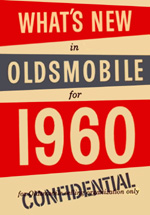 |
|
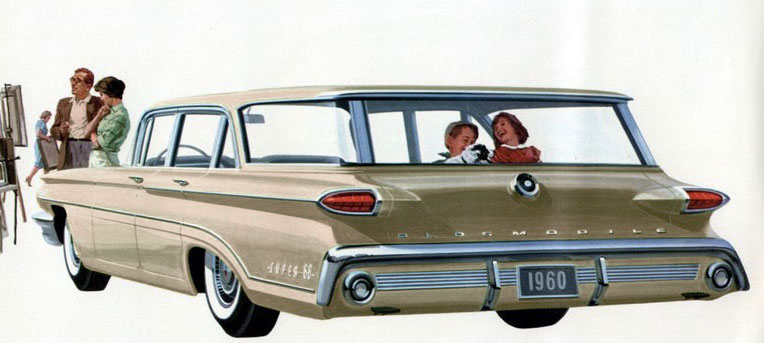
Our first family wagon was slightly used car, a
hand-me-down from Dad's boss. It was loaded with
accessories, AC, leather seats, power windows, seats,
and "Safety Sentinel," which informs the driver that
they have exceeded a pre-set speed.
|
This 1960 models also featured the "Safety Spectrum
Speedometer" with a colored dial that starts out green,
changes to orange at 35 mph, then turns red after 65
mph. It was a "thermometer speedometer" as Dad put it.
An urban myth claimed the speed dial changed color a
fourth time, from red to silver at 100 mph. But us kids
just yelled, "Go red Dad, go red!!!"
The shift quadrant sequence for the Jetaway Hydra-Matic
"Slim Jim" transmission was P-N-D-S-L-R, with reverse
all the way down! Auto safety experts criticized GM for
the Hydra-Matic's a-typical design. Oldsmobile's selling
point was to make it easier for drivers to rock their
cars loose when stuck by having adjacent forward
and reverse gears. GM changed the standard to the more
common P-R-N-D-S-L sequence by 1965.
|
|
|
|
|
|
1960 Oldsmobile Factory Literature
Awesome collection by
www.1960oldsmobile.com
|
|
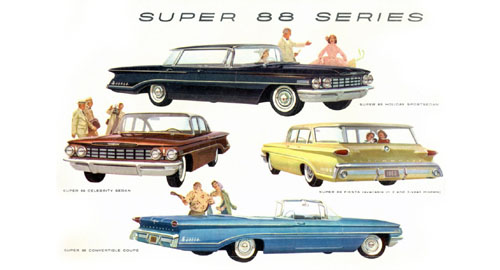 |
| |
|
|
|
 |
|
|
| |
|
|
| |
|
|
| |
|
|
| |
|
|
|
1963 Oldsmobile Dynamic 88
Series 32 Fiesta Sedan - 3
Seat
4 Door, 9 passenger Station
Wagon
Color: Provincial White
|
MSRP: |
$3,566.00 |
|
Model no.: |
3245 |
|
Produced: |
3,878
units (3-seat) |
|
Engine type: |
V-8 OHV |
|
Displacement: |
394 cu. in. |
|
Horsepower: |
280 hp @ 4,400 rpm |
|
Torque: |
430 lb-ft @
2,400 rpm |
|
Compression
ratio: |
10.25
: 1 |
|
Carburetor: |
2-barrel Rochester |
|
Transmission: |
Roto Hydra-Matic 375 |
|
Tire size: |
8x14 |
|
Shipping weight: |
4,354 lbs. |
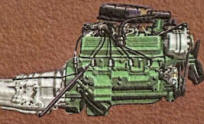
Engine block color for the Rocket 394
V-8s were
green for both 280 hp base and 260 hp versions.
Only high-compression 330 hp version was red.
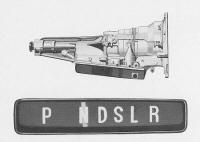
Roto Hydra-Matic 375 Model 10
"Slim Jim" with
"Accel-A-Rotor" torque converter stator.
Reverse was still at bottom
of shift quadrant.
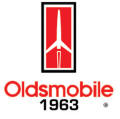
Come and get yours!
Oldsmobile dealership
with '63 models in showroom
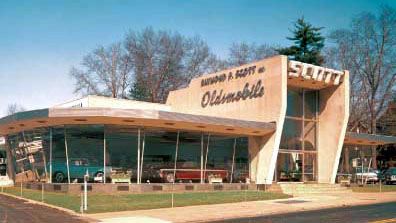 |
|
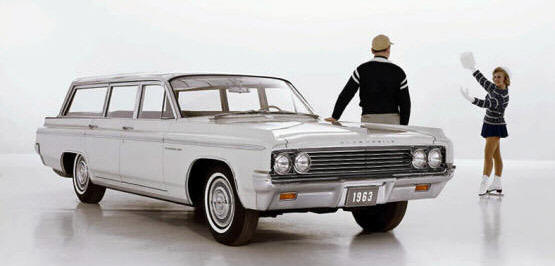 |
|
|
|
Much like the photo that came in a new
wallet, these are not my parents. They were supplied by
Oldsmobile marketing as an optional family. Mrs. Olds
demonstrates Navy semaphore signaling she'll use to
safely land husband in driveway after late nights at the
office--supposedly. |
|
| |
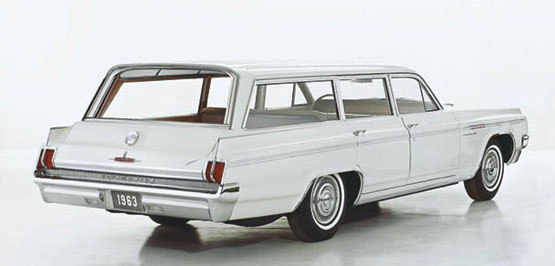
|
Trading
places. You can tell it's a three-seater by the
unmistakable bulge behind the right rear wheel. Fiesta's
spare tire stow space was relocated from center rear of
car to right rear fender area to accommodate the third
seat. Surprisingly, these tanks rolled only 14 inch
wheels, rather than 15 inch that became the norm.
|
|
|
|
|
|
|
It was our very
first factory new wagon like model pictured above,
except it had red interior and small standard hub caps. It didn't have AC, power
windows, or power seats. If memory serves me
correctly it burned premium, which suggests it was most
likely the 280 hp version. It also had the same wacky
P-N-D-S-L-R shift quadrant sequence as the '60 Olds.
For 1963, buyers could choose from one of three 394-cu.in. V-8
Rocket engines, each with the same bore and stroke and hydraulic lifters. The base version
had a two-barrel carburetor and 10.25:1 compression
ratio, produced 280hp and 430-lbs.ft. of torque. A
no-cost economy version made just 260hp and 410-lbs.ft.
of torque, with its reduced 8.75:1 compression. The performance 394 started with the base
version and added a four-barrel carburetor, which bumped
output to 330hp and 440-lbs.ft. of torque.
Amazingly, a column-shifted
three-speed manual transmission was standard; however, most owners
opted for the Roto Hydra-Matic 375 (Model 10) dubbed
"Slim-Jim". It was intended to be a more efficient
automatic--there was no torque converter, rather an
internal fluid coupler, it instead became problematic
for owners.
The Roto Hydra-Matic did not have a conventional fluid
coupling or torque converter but had an internal fluid
coupling with a torque multiplier. There was no real
bell-housing; instead, there was a kind of flange
connecting the transmission to the engine. The power
flow from the engine crankshaft to the transmission
input shaft was connected via a flywheel containing a
set of springs to absorb torsional vibrations at the
flex plate. The shifting sequence was very different and
much rougher than the Hydra-Matics that preceded it, or
the Super Turbines and Turbo Hydramatics that followed
it. |
|
|
|
|
|
1963 Oldsmobile Color Codes
|
C |
#8259 - Provincial White
Scharch Family Wagon |
|
|
S |
#22269 - Saddle Mist Poly.
Brynelson Family Wagon
|
|
|
W |
#12696 - Midnight Mist
Poly.
Baer Family Wagon |
|
Note: "Poly." is metallic
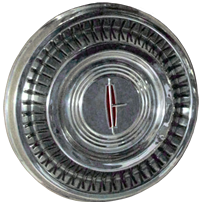 |
|
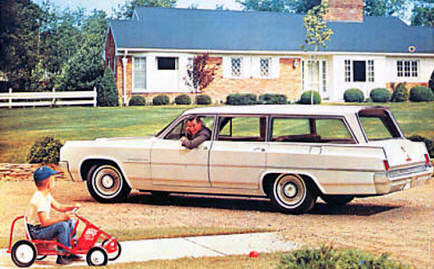
|
|
|
|
|
|
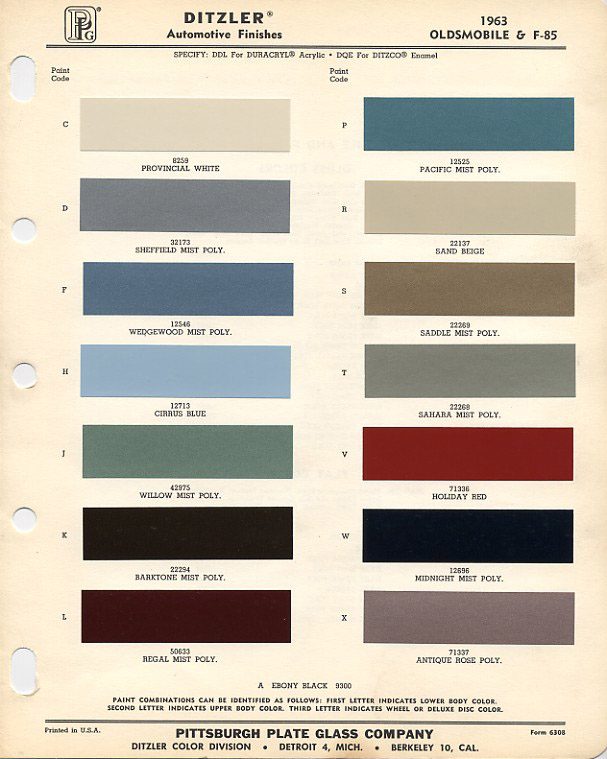 |
|
Our
family Fiesta was same Provincial White color with small dog dish
hubcaps. On long trips kids do get rambunctious. A button on the
dash controlled the tailgate window and afforded dads
the ability to control childrens' nap time. Just lower
the window and let the exhaust backdraft put your kids
to sleep.
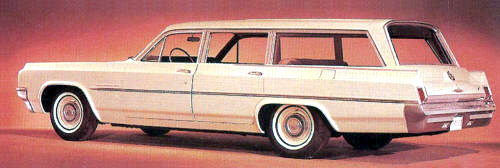
|
1963 Oldsmobile Dynamic 88 Fiesta 3-seat
Station Wagon (Provincial White)
|
|
|
|
|
|
|
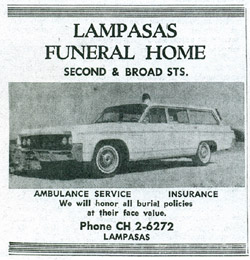 |
|
There were three '63 Fiestas within two blocks. Our white wagon, Baer's
deep blue, and Brynelson's "golden bomb".
As I recall, Baer's Eighty-Eight had AC, and Brynelson's burned
Regular, which suggests it was the low
compression 260 hp Economy version.
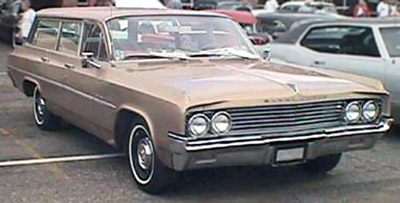 |
|
1963 Oldsmobile ambulance conversion
Lampasas Funeral Home, Lampasas,
TX.
|
|
|
|
1963 Oldsmobile Dynamic 88 Fiesta 3-seat
Station Wagon (Saddle Mist)
|
|
|
|
|
|
|
|
|
|
|
|
|
|
|
|
|
|
|
1969 Oldsmobile Vista
Cruiser
Series 34800 Station Wagon
3-seat
4 Door, 9 passenger Station
Wagon
Color: Topaz
|
MSRP: |
$3,583.00 |
|
Model no.: |
34865 |
|
Produced: |
21,508 units (3-seat) |
|
Engine type: |
V-8 OHV |
|
Displacement: |
350 cu. in. |
|
Horsepower: |
310 hp @ 4,800 rpm |
|
Torque: |
390 lb-ft @
3,200 rpm |
|
Compression
ratio: |
10.25
: 1 |
|
Carburetor: |
4-bbl Rochester Quadrajet |
|
Transmission: |
Turbo Hydra-Matic |
|
Tire size: |
8.25 x 14 |
|
Shipping weight: |
4,063 lbs. |
|
|
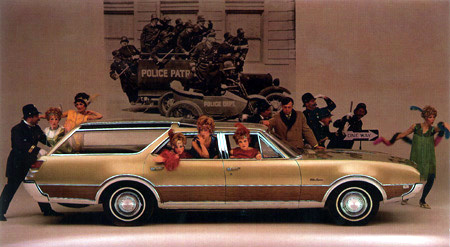
|
A magazine ad for the '69
Vista Cruiser 3-seat. Exactly like one neighbor owned.
(Topaz/Wood Grain) |
|
|
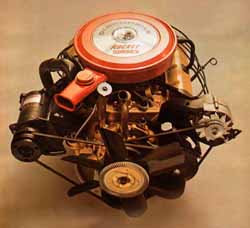
It had the optional engine, the most powerful
350 V-8 available from Olds in '69. OEM engine color was
gold.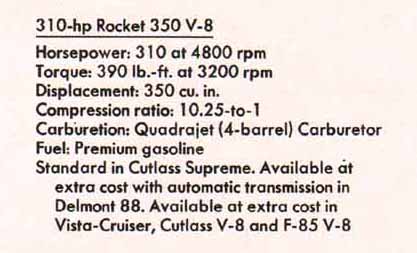 |
|
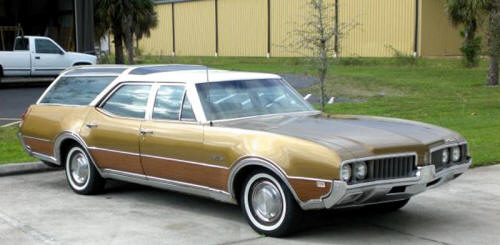
My friend's
mother drove one of these gold and wood paneled Vista
Cruisers, and we lived in Madison, WI. It had surprising
power and flew! It was a sleeper and very fast for a
2-ton mid-sized family wagon. Curb weight was 600 lbs.
more than it's brother, the 2-door Cutlass coupe.
The Vista
was identical to the station wagon that commonly
appeared on the TV period sitcom That '70s Show,
which aired on Fox television network from
1998 until 2006. Ironically,
the show was also about the lives of a group of teenage
friends living in the fictional suburban town of Point
Place, Wisconsin, from May 17, 1976, to December 31,
1979. The resemblance was so uncanny it made me think if
one of the show's writers was from Madison and knew us.
If it were actually fact, then I'd say either Topher
Grace or Ashton Kutcher was cast to play my part.
|
|
|
|
|
|
1967
Pontiac Catalina
Series 25200 Safari 3 Seat
4 Door, 9 passenger Station
Wagon
Color: Montreux Blue
Nickname: "The Batmobile"
|
MSRP: |
$3,374.00 |
|
Model no.: |
25245 |
|
Produced: |
11,040
units (3-seat) |
|
Engine type: |
V-8 OHV |
|
Displacement: |
400 cu. in. |
|
Horsepower: |
290 hp @ 4,800 rpm |
|
Torque: |
428 lb-ft @
2,500 rpm |
|
Compression
ratio: |
10.5
: 1 |
|
Carburetor: |
2-bbl Rochester |
|
Transmission: |
Turbo Hydra-Matic |
|
Shift pattern: |
P-R-N-D-S-L (normal) |
|
Options: |
AC, PS, & PB |
|
Tires: |
8.55 x 14 |
|
Shipping weight: |
4,340 lbs. |
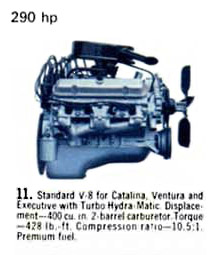
Standard '67 Catalina engine was a
high compression 400 V-8 2-bbl. |
|
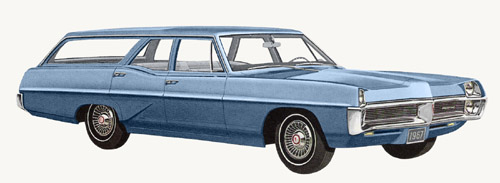
Our '67 Catalina was a plain Jane
model with small hubcaps, but had optional air
conditioning
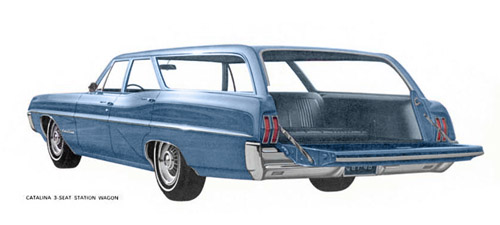
Rear view showing open tailgate and
backward facing third seat.
The
1967 Catalina and other full-sized Pontiacs was a
redesign year and received a heavy face-lifting of the
1965/66 body shell, with more rounded
wasp-waisted body contours and fuller fastback
rooflines. It also had concealed windshield wipers, an
industry first, although they are not shown as hidden in
first brochure image above.
The new 400 and 428 cubic-inch V8s replaced the 389 and
421 V8s of previous years. The standard Catalina engine
was a two-barrel unit rated at 265 hp with three-speed
manual transmission or 290 hp with Turbo Hydra-Matic.
The 265 hp engine was available as a no-cost optional
economy engine with
the Turbo Hydra-Matic. The lower compression alternative
used Regular gas instead of Premium.
|
|
|
|
|
|
|
|
|
|
Station Wagon
Story |
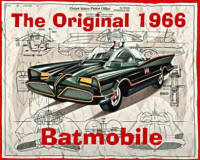
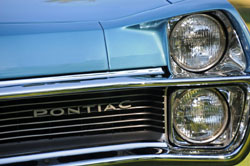
Montreux Blue
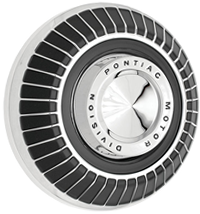
Pontiac Motor Division small (dog dish) hubcaps
were on our '67, with rims matching body color.

1967 Pontiac Custom Air Conditioning
|
|
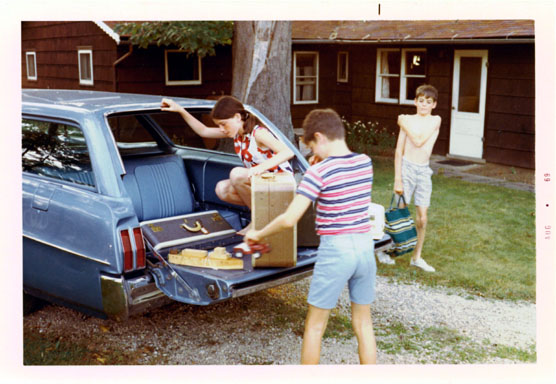
|
Our
three-seat Catalina shortly after arriving
at Grandpa's home in Green Lake. Paula, Stan
and I were charged with unloading of suite
cases and whatnots. My
brother and I rode the entire trip together
in the third seat with luggage under our
feet, facing backward.
Photo of child labor camp taken by Dad in
'69. |
This was our first Pontiac wagon, time to switch
brands or GM divisions. It was
brand-new and had that new car smell of freshly molded
plastic. Dad picked it up at the dealer just a day or
two before our summer vacation trip to the lake.
Every year we drove up to
Grandpa's in Green Lake, Wisconsin. He had a
modest lake home and cabin on Dartford
Bay. He bought it in the '40s and built a small cabin
near the shoreline. In the '50s, he also hand-built
a
two-bedroom house with a three-season porch.
Our maiden voyage in the new Pontiac began on a Friday.
It was already getting hot when we shoved-off around
noon. Even though this new wagon had air
conditioning, our parents didn't turn it on until half-way through
a nearly two-hour trip. Dad
thought we could tough-it-out with the windows down and
the air off. I believe his rationale was that our
previous wagon didn't have air, so why should we
need it now. Like, it should only be used when you
really need it for relief, just not for comfort. I
think he was worried we'd become AC dependent.
That idea didn't make much sense to seven kids
packed together like sardines in a frying pan,
sticking to hot vinyl seats. We waited with much anticipation
to experience Dad's magical world of automobile air
conditioning. We had been taunted long enough. (Turn it on already!)
It wasn't too uncommon to feel tormented by his
morbid curiosity, this time, to see
if we could make the whole trip without turning on the AC. He finally gave into his kids demands
to turn on the air. Then he had us roll up the windows,
which we needed
permission to do.
It was at this point in time, when we felt cool
air on our faces, that we became permanently spoiled
by air conditioning, and dependent as Dad feared. I
remember feeling
privileged and with cool air of entitlement, and wasn't
about to dial back the auto accessory clock.
After turning
onto our grandfather's gravel driveway, we drove up to the house and parked
to unload the wagon. I remember getting
out of the car with a little trepidation, realizing that
it was summer and hot outside. I had to give
up my air conditioning dependence, and get busy
unloading the wagon.
|
|
|
|
|
|
|
|
|
|
|
|
|
|
|
|
|
|
1972
Pontiac Safari
4 Door, 9 passenger Station
Wagon (3 seat)
Color:
18,2430,
Antique Pewter Poly
Nickname: "The Hearse"
|
MSRP: |
$4,372.00 base |
|
Model no.: |
2L45 |
|
Produced: |
12,766 units (3-seat) |
|
Engine type: |
V-8 OHV |
|
Displacement: |
400 cu. in. |
|
Horsepower: |
175 hp (net) @ 4,000 rpm |
|
Torque: |
310 lb-ft @ 2,400 rpm |
|
Compression
ratio: |
8.2 : 1 |
|
Carburetor: |
2-bbl Rochester |
|
Transmission: |
Turbo Hydra-matic |
|
Tires: |
L78-15 (bias ply) |
|
Overall length: |
222.4" (18'-6 3/8") |
|
Shipping weight: |
4,818
lbs. |
|
|
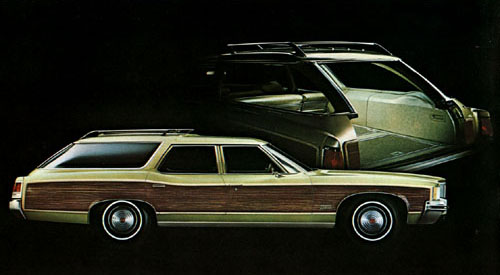 |
|
|
|
|
Some serious tonnage at 4,818
lbs. is nearly 500 lbs. more than our
previous 1967 "Ponti-hog" 3-seater.
(Color shown Springfield
Green) |
|
|
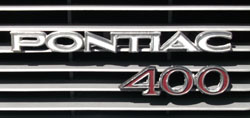
Other Features
Cruise Control - Glide-away
disappearing tailgate
Power tailgate window
(recedes into roof)
Split-back second seat - Forward-facing third seat
Windshield antenna - Concealed wipers
Energy absorbing bumpers - Power steering
Power brakes, front discs, rear
drums
Front coil-spring and rear leaf-spring
suspension |
|
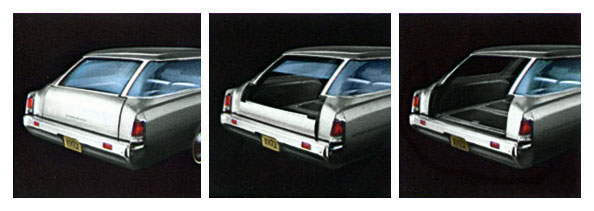
|
The "Glide-away", or
disappearing tailgate, receded below the
floor. The power tailgate window receded
into the roof. Teenage drivers are
adventurous; the bomb-bay doors could be
operated while coasting in neutral, as my
brother discovered. (Color shown Adriatic
Blue) |
|
|
|
|
|
|
|
|
|
|
|
|
Station Wagon
Story |
|
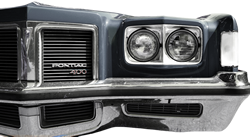
Antique Pewter |
|
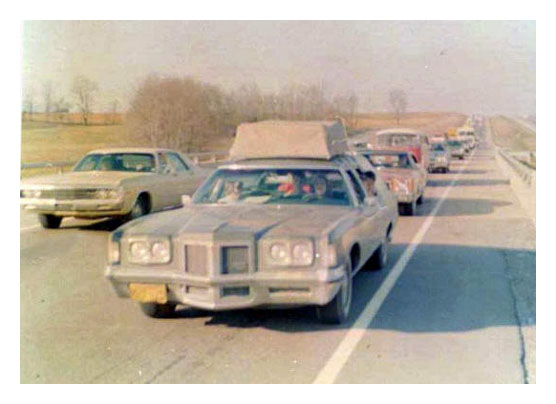
|
Our trip to Florida in
March 1972 in the new wagon.
Under-exposed photo taken by Dad, during
holiday traffic jam on Georgia's I-75.
Paula is at the wheel, with Stew, Stan,
Stacy and Mag riding along in
bewilderment. Shadow casts show it was
late afternoon. |
|
|
|
|
Our Florida-bound drive was mostly smooth sailing;
but to everyone's surprise, we hit a traffic jam in
the middle of nowhere, southbound through Georgia on
I-75. It was actually a fairly new stretch of
interstate, which became a parking lot in the blink
of an eye. It was stop and roll traffic for an hour
or two.
That's when Dad got the idea to stretch his legs to
work off some tension by taking a short jog down the
shoulder of the highway. He was an engineer with
hidden artistic talent, having a mindset that
fostered quick simple solutions to challenges. He
was never afraid to try a new route or shortcuts on
other trips.
But, to work off angst and abandon your children on
a highway halfway across the country seemed
ridiculous. One of my siblings said explicitly, "Dad
- you are NOT!"
He downplayed his crazy idea of abandoning the SS
Pontiac’s helm (and us) just to get in 5-10 minutes
of exercise. For him, it was a no brainer and a feeling none
of his kids shared. Yet, we realized there would be
entertainment value in witnessing his stunt.
So, Dad gave the wheel over to Paula, who just got
her driver’s license and told her, "If cars start
moving just keep driving alongside me… I’ll keep up
with you, and hop back in before traffic takes off.
This situation reminded me of a neighborhood family,
whose kids I was pals with. Often while driving home
on some errand they’d let their small black
poodle out a block early, then take off. We laughed
and cheered little Chi Chi on, who had a top end of
about 30 mph. He loved to run alongside the car too.
Like a Chinese fire drill, Dad said to Paula,
“Ready… go!” Out the door he went, and in jumped Paula.
It was like a driver change at the 24 Hours of Le
Mans.
Our jaws were hanging, and were a bit embarrassed
when we noticed other drivers around us doing the
same. We still wondered if we’d become orphans, that
somebody would call police or contact child
services. That’s when I visualized someone in white
chasing Dad with a net as they ran down the shoulder
together.
His little jog was ten minutes or less, running in
the direction of traffic. It was also a scouting
mission to observe how far cars were backed up. A
couple of other drivers looked over at us with
concern and shouted through their windows at us. "Is
everything okay? You guys alright?" We laughed
sheepishly, rolled our eyes and said, “Yeah, that’s
our dad.”
Then cars began to creep forward more and more.
Paula began to panic, realizing none of this was on
her recent drivers exam. We were beginning to catch
up with dad, just like he said. Traffic was
beginning to move faster, and Dad was sizing up the
moment when he and Paula could make another driver
switch.
It was like a movie, where some bum is running along
the tracks trying hop in a moving train. Luckily
traffic stopped dead again and Paula put the car in
park and got out. Then one of the other stranded
drivers asked Dad, So… see anything up there?" A few
minutes earlier that driver was flustered that Dad’s
jog was going to make things worse, and now the guy
wanted a traffic report from him! It became a moment
of levity.
That’s when Dad grabbed his 35 mm camera from the
car and took a photo of us kids in the car on the
jam packed Interstate.
|
|
|
|
|
| |
|
 |
|
|
|
Some Rights Reserved |
|
|
|